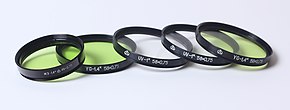Filter (optics)
Optical filters select the incident radiation according to certain criteria, e.g. B. according to the wavelength , the polarization state or (usually as a side effect) the direction of incidence . The more well-known optical filters ( color filters , UV filters ) are presented in the article Filters (photography) .
Graduated filter
Graduated filters have a filter effect that continuously changes over the filter surface. They are used to achieve continuously adjustable attenuations, for example as a shiftable gray wedge over a narrow beam path - where the gradient of the filter can be neglected or the beam profile is not influenced (for example, a laser beam, if its intensity distribution follows the Gaussian bell curve, only laterally offset).
Graduated filters also include the usually neutral gray center filters , which are used in photography, particularly with extreme wide-angle lenses , in order to compensate for the peripheral light drop that occurs there due to the Cos 4 law .
Edge filter

An edge filter has two more or less sharply separated spectral ranges in which the filter transmits (is permeable) or absorbs (is impermeable). It is usually designed as a high-pass filter ; low-pass edge filters can only be implemented with poor off-band suppression. Since in optics the focus is more on wavelength than frequency, instead of high-pass or low-pass, one speaks of long-pass ( cut-off filter ) and short-pass filter ( cut-in filter ), depending on whether the long-wave or the short-wave spectral components are allowed through. The filter-specific wavelength that separates the absorption and transmission range from one another is referred to as the edge.
Polarizing filter
The polarization filter consists of anisotropic foils or dielectric surfaces that work in reflection . It is used in photography to influence reflections.
Interference filter
The interference filter is a filter based on interference effects in optical thin films. In addition to edge filters, polarization filters and graduated filters, interference filters with a very narrow passband and a high degree of suppression of the off-band range can be produced. The transmission range (or useful range) is the wavelength range (or spectral range) in which the filter has a high permeability ( transmission (physics) ). The spectral range outside of this transmission range is called offband. The quality of a filter is shown here in the lower transmission values: in the case of interference filters, this radiation is reflected , in the case of "normal" color filters it is absorbed . Interference filters are used, for example, to suppress infrared radiation in image sensors in digital cameras and in projection systems. The international standard ISO 9211 (Optics and Photonics - Optical Layers) is used to specify optical interference filters . This consists of the parts
- Part 1: Terms
- Part 2: Optical properties
- Part 3: Environmental Resistance
- Part 4: Specific test methods.
Bayer filter
This is a structured color filter corresponding to each pixel of a CCD - or CMOS - sensor vorschaltet its own color separation filter, which only a respective wavelength range to pass through (red, green or blue). Four light-sensitive pixels are combined into one color pixel, see Bayer sensor .
Complementary color filter
This filter is structured in the same way as the Bayer filter described above, but instead of using the primary colors of the additive color mixture (red, green, blue), it works with their (additive) complementary colors ( magenta , cyan , yellow ). This doubles the sensitivity to light, because a primary color filter blocks 2/3 of the spectral range (a green filter, for example, blocks red and blue), while a complementary color filter blocks only 1/3 (e.g. a yellow filter only blocks blue). This advantage comes at the price of more complex electronic color decoding.
Complementary color filters may be used. a. built into camcorders in order to be able to achieve large zoom factors (25x and more) with compact dimensions and correspondingly very small sensor areas , without increasing the electrical signal amplification in the readout circuit and thus the signal noise too. Complementary color filters, on the other hand, are rarely found in current digital cameras .
Individual evidence
- ↑ ISO 9211-1: Optics and photonics - Optical layers - Part 1: Terms (ISO 9211-1: 2010), Beuth Verlag.
- ↑ ISO 9211-2: Optics and optical instruments - Optical layers - Part 2: Optical properties (ISO 9211-2: 1994), Beuth Verlag. This standard has been revised and the successor version is already available as DIS (Draft International Standard).
- ↑ ISO9211-3: Optics and photonics - Optical layers - Part 3: Environmental resistance (ISO 9211-3: 2008), Beuth Verlag.
- ↑ ISO 9211-4: Optics and optical instruments - Optical layers - Part 4: Specific test methods (ISO 9211-4: 2006), Beuth Verlag.
